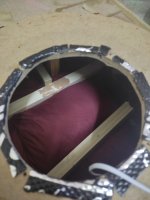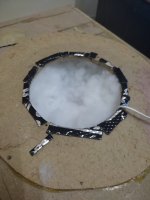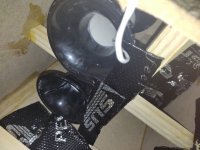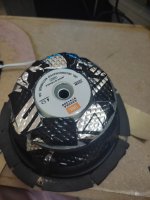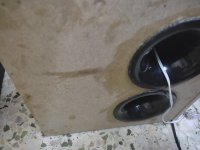im driving a 2x12 ROAR HARD and 200cm2(each) for 210 cm and 800-1000cm2(each) for 120cm. the drivers are horizontally opposed right at the 1/4 wave sections Vmax/exit). its wierd(the swishy sound).
cant attach image for a day or two(it would likely help the diagnosis instead of this ambigouis, "guess for me"😀) but will these sound distinctivley unique to rule one out over the other..
cant attach image for a day or two(it would likely help the diagnosis instead of this ambigouis, "guess for me"😀) but will these sound distinctivley unique to rule one out over the other..
Listening to a microphone output through headphones can nelp localize the noise- easy to move a mic around the cabinet interior, not so much with your head.its wierd(the swishy sound).
cant attach image for a day or two( but will these sound distinctivley unique to rule one out over the other..
An image won't help us hear the swishy sound, but a slow sine wave sweep should inform you as to whether it is a localized leak or general turbulence.
If the magnets are vented and in the exit, you could be also find their noise as "wierd" or weirder 😉.
Ideas that had work so far for me with my subwoofer build ... Keep improving ...im driving a 2x12 ROAR HARD and 200cm2(each) for 210 cm and 800-1000cm2(each) for 120cm. the drivers are horizontally opposed right at the 1/4 wave sections Vmax/exit). its wierd(the swishy sound).
cant attach image for a day or two(it would likely help the diagnosis instead of this ambigouis, "guess for me"😀) but will these sound distinctivley unique to rule one out over the other..
Port noise could be dealt with using double large flared aeroports ... From my experience ... Make sure to seal it from the mounting inside too ... Some air can leak past there
Drivers ... Some soundproof sheets proved to be useful .... Attach them behind the magnet frame and basket frame assembly ... Some polyfiber and loose pillow may help with the noise too
Mount the drivers really air tight by using modelling clay to make driver gaskets ... Works for me so far so good
Box ... That is something needs to pay attention too ... Wood glue alone is not enough ... Sometimes i need to layer it with silicone and even some wood putty filler to make it really sealed
Below photos showed how i prepped for the subwoofer box treatment ... Might be considered overkill 🤣😅
Attachments
I have made myself a simple tool to diagnose these localized noise issues in speakers due to previous challenges I've had with other designs.Listening to a microphone output through headphones can nelp localize the noise- easy to move a mic around the cabinet interior, not so much with your head.
An image won't help us hear the swishy sound, but a slow sine wave sweep should inform you as to whether it is a localized leak or general turbulence.
If the magnets are vented and in the exit, you could be also find their noise as "wierd" or weirder 😉.
The solution simply is a modified stethoscope. I removed the actual head of the stethoscope and extended it with more silicone tubing (model RC engine fuel tubing), keeping one end of tubing open and moving it around the suspect areas.
This allows for very pin point location of noise sources and issues. Despite also being a useful tool to troubleshoot this, a mic can't isolate a small problem area as well and is a bit more complicated, needing extra supporting equipment ie. headphones, preamp,.etc.
Are you hearing the noise created by the speaker pole piece vents at higher excursion?
Could also be insufficient venting of the dust cap area, causing noise to leak acoustically from the cone surface?
Is the surround leaking due to pin holes or porosity?
Voice.coil venting issues causing air turbulence noise?
Some drivers are noisier than others at high excursion levels. The better drivers are engineered with that in mind and distort less at higher output levels by means of venting the VC more thoroughly and keeping excessive air speed down in that area.
Could also be insufficient venting of the dust cap area, causing noise to leak acoustically from the cone surface?
Is the surround leaking due to pin holes or porosity?
Voice.coil venting issues causing air turbulence noise?
Some drivers are noisier than others at high excursion levels. The better drivers are engineered with that in mind and distort less at higher output levels by means of venting the VC more thoroughly and keeping excessive air speed down in that area.
akward!! as turns out one driver being driven by a (slighty, differrnt signal with XO completely *** backwards and steep slope it seems(imagine sub channel and rear speaker channel difference)
.... wow?, RCA buggered internally as wired between channels or the software is fuct in the XO/fake DSP?etc of the head unit.... i dunno, hard to tell after just removing it and curing it and exciting results.
time to ditch the head unit all together and just go from phone to dsp to amps...or similar source
.... wow?, RCA buggered internally as wired between channels or the software is fuct in the XO/fake DSP?etc of the head unit.... i dunno, hard to tell after just removing it and curing it and exciting results.
time to ditch the head unit all together and just go from phone to dsp to amps...or similar source
Last edited:
That's frustrating. Nothing like simple issues causing major ones. Just goes to show how sometimes we don't see the trees due to the forest being in the way - lol. Its the little things that usually get you and I can't count how many times its happened to me.
- Home
- Loudspeakers
- Subwoofers
- port noise vs driver/baffle leak ?
